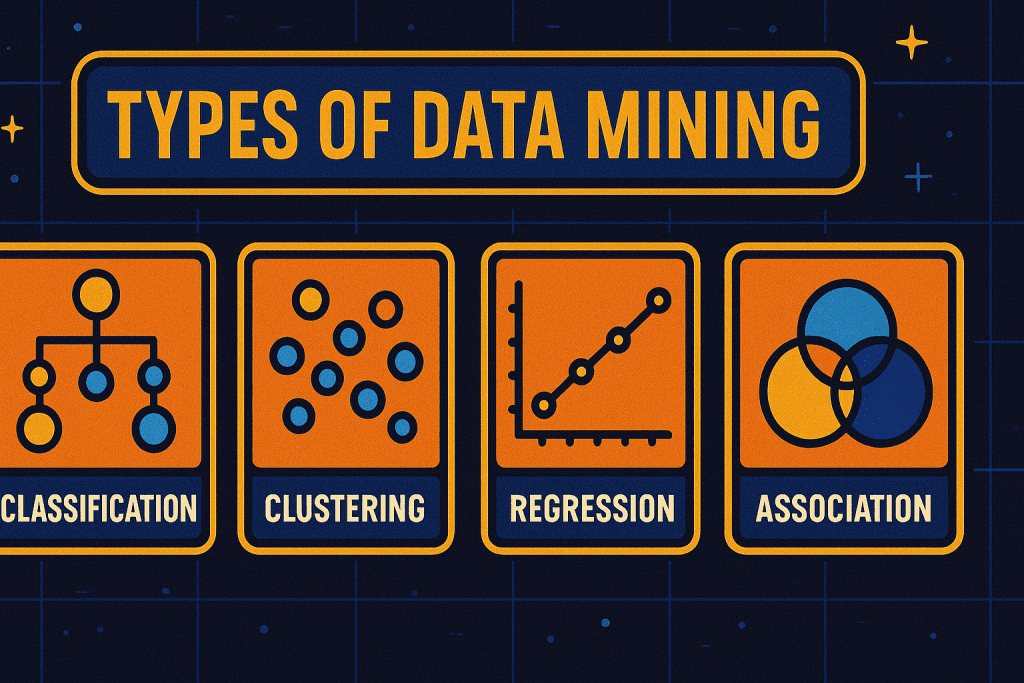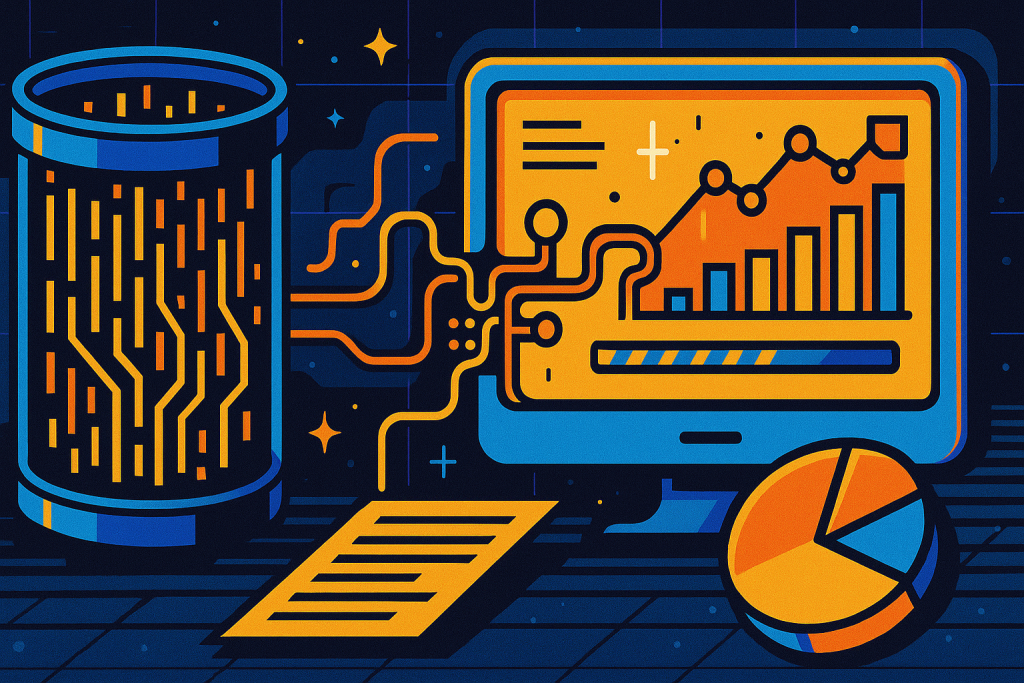Data Mining helps people find patterns and knowledge in large collections of data. It plays a central role in data science, analytics, and digital business. In this article, you will see what Data Mining means in simple terms and why it matters in today’s data-driven world. You will also get a clear picture of how it supports better, faster decisions in many fields. First, we will define and its purpose within the wider analytics lifecycle. Then we will explore its main components, background, and history. After that, you will learn about the key types of Data Mining and how the overall process works in practice. You will also see its pros and cons, along with real-world applications in sectors such as finance, healthcare, and online services. By the end, you will understand how it turns raw information into useful, actionable insight.
What is Data Mining?
Data Mining is the process of analyzing large datasets to discover patterns, trends, and relationships that support decision-making. It uses methods from statistics, machine learning, and database technology to turn raw records into insights that people and organizations can act on. The main goal is to solve real problems, such as predicting customer behavior, detecting fraud, or finding opportunities for growth.
In practice, It sits within the broader field of data science and analytics. It focuses on extracting knowledge from data, while earlier steps handle collection, storage, and basic reporting. Typical its work includes cleaning and preparing data, selecting relevant features, and applying algorithms that classify, cluster, or predict outcomes. Results then feed into reports, dashboards, or automated systems that support business users. When done well, Data Mining connects specific questions with reliable, data-driven answers and becomes a core part of everyday decision-making.
Background of Data Mining
Data Mining relies on several core elements that work together as a pipeline. These elements guide how raw data becomes meaningful insight. At the start, organizations gather information from different data sources, such as databases, logs, or online platforms. Modern tools and software connect to these sources and prepare data for analysis using efficient computer systems.
Once data is available, analysts and data scientists explore it, choose useful variables, and build models. The models apply algorithms that learn from historical examples and reveal patterns that would be hard to see manually. Results are then evaluated, deployed, and monitored to ensure they stay accurate over time.
List of Key Components or Aspects:
- Data collection and integration to bring data from multiple internal and external sources into a central repository.
- Data cleaning and preparation to handle missing values, errors, duplicates, and noise.
- Feature selection and transformation to choose important variables and reshape them for better modeling.
- Mining algorithms and models such as classification, clustering, regression, and association rules.
- Evaluation and validation to test model performance and avoid overfitting.
- Deployment and monitoring to embed models in real processes and track their results in production.
Together these components form a repeatable process that supports consistent, trustworthy insights.
History of Data Mining
The history is tied to the growth of digital data and databases. Early computer systems in the 1960s and 1970s allowed organizations to store structured records electronically. In the 1980s, relational database systems and SQL made it easier to query and manage large datasets. As data volumes grew further, people began to search for automated ways to discover useful patterns instead of relying only on manual analysis.
The specific term “data mining” first appeared in academic work during the 1980s. In the 1990s, it became more widely used as a label for techniques that combined statistics, database research, and artificial intelligence to uncover hidden knowledge. One key moment was the First International Conference on Knowledge Discovery and Data Mining in 1995, which helped formalize the field. Since then, advances in big data, cloud computing, and machine learning have allowed Data Mining to scale to billions of records and support applications across almost every industry.
| Year / Period | Milestone | Description |
|---|---|---|
| 1960s–1970s | Early digital databases | Organizations start storing structured data electronically. |
| 1980s | Relational databases and SQL | Standard tools emerge for querying and managing large datasets. |
| 1983 | Term “data mining” first used in economics | The phrase appears in academic literature. |
| 1995 | First KDD conference held | International conference on Knowledge Discovery and Data Mining launches. |
| Late 1990s | Commercial Data Mining tools | Vendors release software platforms focused on pattern discovery. |
| 2000s–Today | Big data and cloud-based analytics | Data Mining integrates with big data, cloud, and large-scale ML systems. |
Types of Data Mining
This includes several main types, each suited to a particular goal. Together they support description, prediction, and detection tasks across many use cases.

Classification
Assigns items to predefined categories. For example, it can label emails as spam or not spam, or decide whether a loan application is likely to be approved. Models learn from historical data where the correct labels are known.
Clustering
Groups similar items without predefined labels. It helps reveal natural structures in the data, such as customer segments that share similar behavior or needs.
Regression
Predicts numeric values, such as future sales, prices, or demand. It fits a function to the data and then uses it to forecast outcomes.
Association rule mining
Looks for items or events that occur together, such as products often bought in the same shopping cart. This is useful for recommendations and store layout planning.
Anomaly detection
Identifies unusual records that differ from normal patterns. It often supports fraud detection, fault monitoring, or security alerting. These types of Data Mining are frequently combined in real projects to provide a richer picture of the underlying data.
How Does Data Mining Work?
Data Mining follows a structured series of steps. First, teams define the business problem, such as reducing churn or improving credit decisions. They decide what success looks like and which questions the analysis should answer. Then they identify and collect relevant data, pulling it from internal systems, external feeds, or data warehouses.

Next comes data preparation. Teams clean the data, fix errors, remove duplicates, and handle missing values. They select important features and transform them if needed. After that, they choose algorithms aligned with the task, such as classification, clustering, or regression. Models are trained on historical data and evaluated using metrics like accuracy, precision, or error rate. If performance is acceptable, the model is deployed into production systems, where it can score new data in real time or in batches. Finally, results are monitored and models are updated as data and conditions change.
Pros and Cons of Data Mining
Data Mining offers many advantages, but it also brings real risks and challenges. Leaders should weigh both sides before investing in tools, projects, and teams.
| Pros | Cons |
|---|---|
| Improves decision-making with evidence | Raises privacy and security concerns if mismanaged |
| Reveals hidden patterns and trends | Can embed bias from poor or unbalanced data |
| Supports automation of complex analysis | Requires skilled staff and strong governance |
| Increases efficiency and cost savings | Tools and infrastructure may be expensive |
| Enhances customer insight and targeting | Misuse can harm trust and brand reputation |
When handled responsibly, with proper controls and transparency, Data Mining can drive growth, innovation, and better services. Poor design or weak oversight, however, can lead to errors, unfair outcomes, or regulatory issues.
Applications or Uses of Data Mining
Data Mining appears in many areas of daily life and industry. It helps organizations understand behavior, manage risk, optimize operations, and improve user experiences. As data continues to grow, its impact becomes even stronger.
Customer analytics and marketing
Companies study purchase history, browsing behavior, and feedback to segment customers, design targeted campaigns, and recommend products. This improves loyalty, conversion rates, and overall revenue.
Finance and fraud detection
Banks and payment providers analyze transaction patterns to spot unusual activity. Models flag suspicious operations for review, support credit scoring, and help manage portfolio risk.
Healthcare and medicine
Hospitals and researchers mine patient records, images, and clinical data. They identify risk factors, improve diagnoses, and measure treatment outcomes, which supports better care and planning.
Manufacturing and operations
Factories use Data Mining to predict equipment failures and optimize production processes. Insights guide maintenance, reduce downtime, and improve quality, often working in combination with robots that perform precise, repetitive tasks.
Online services and personalization
Streaming platforms, social networks, and other digital services use Data Mining to suggest content and personalize experiences. They rely on scalable computer systems to handle massive data streams in near real time and adjust recommendations as user behavior changes.
Resources
- Youtube. What is Data Mining?
- IBM. What Is Data Mining?
- Caltech. What Is Data Mining?
- Tpointtech. Types
- intellspot. 14 Types of Data Mining: Beginner’s Guide
